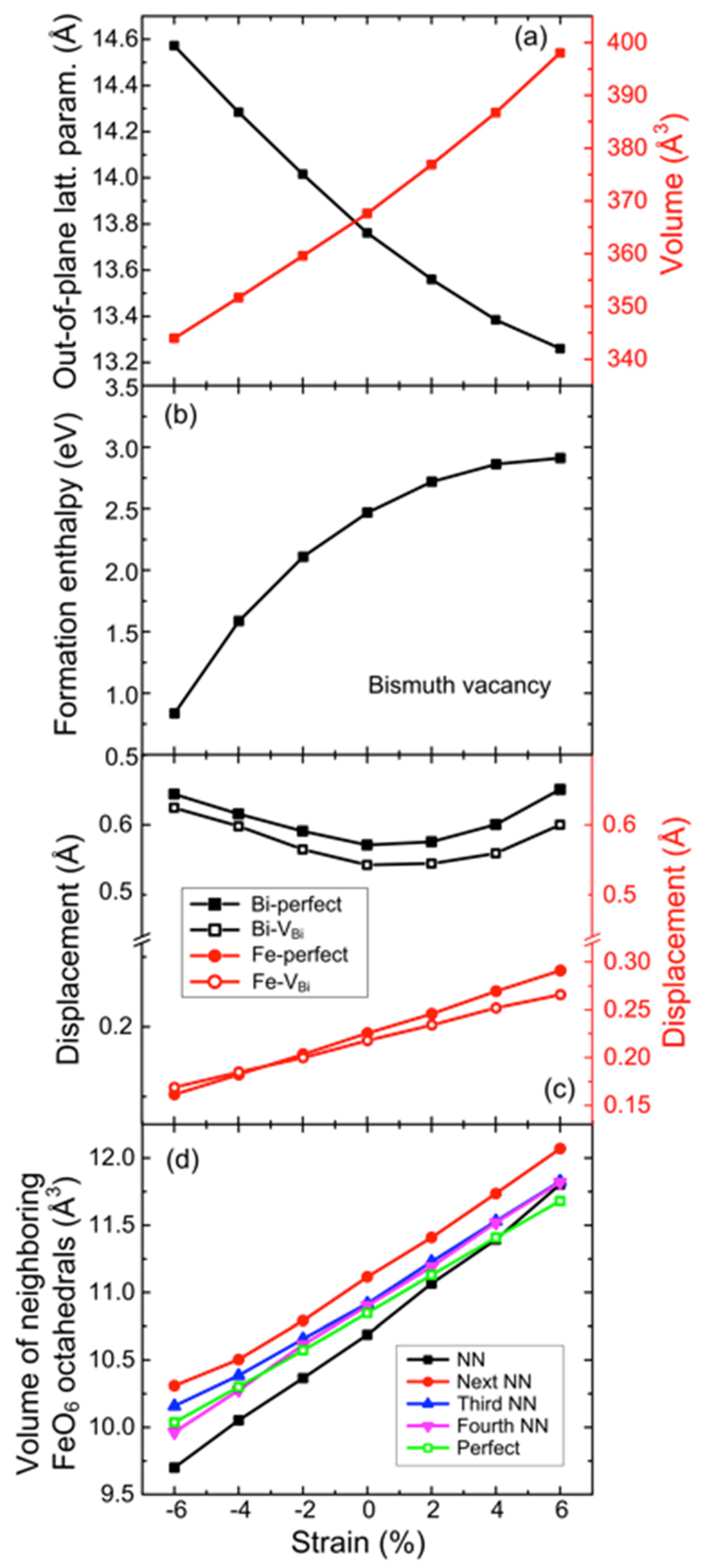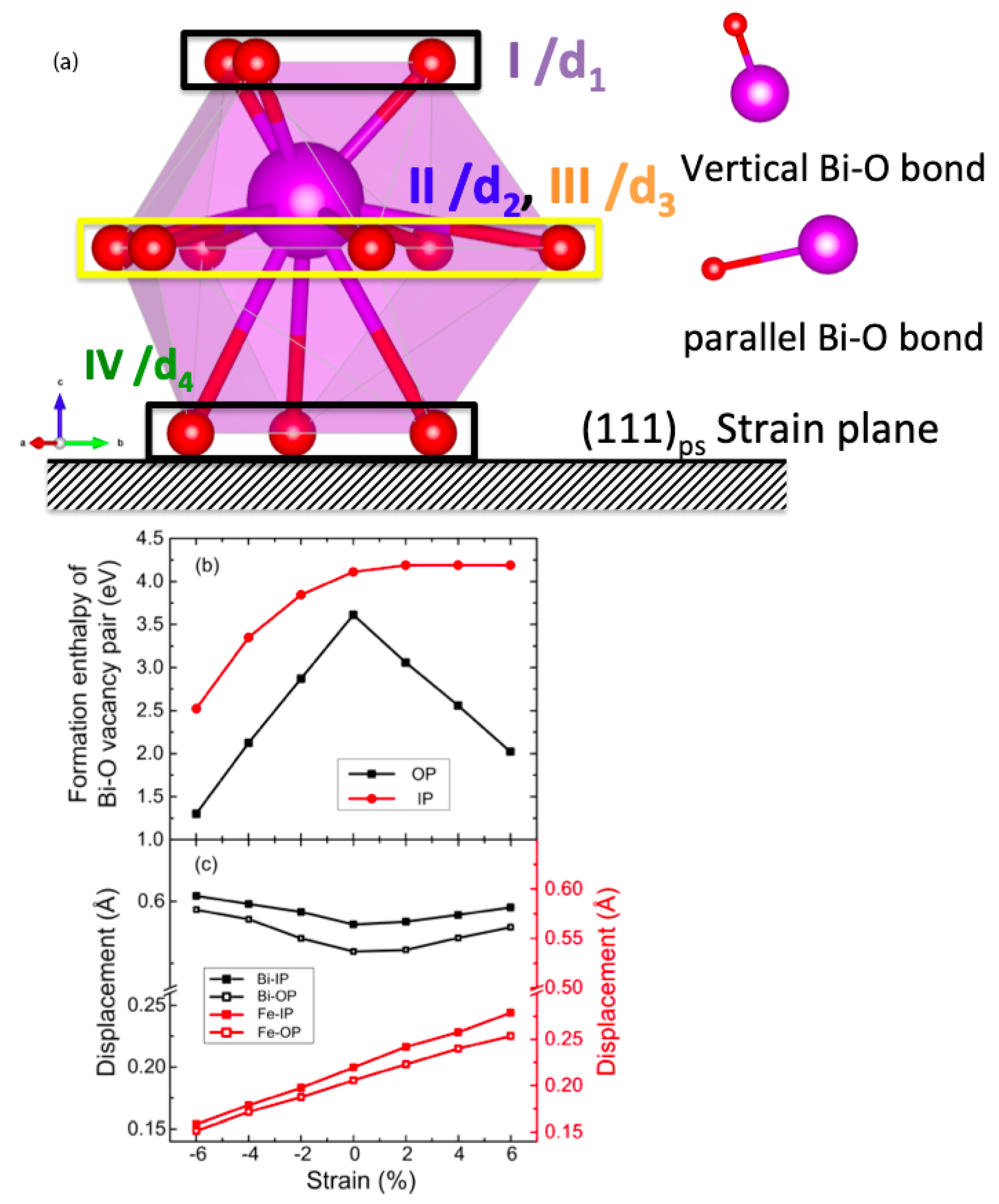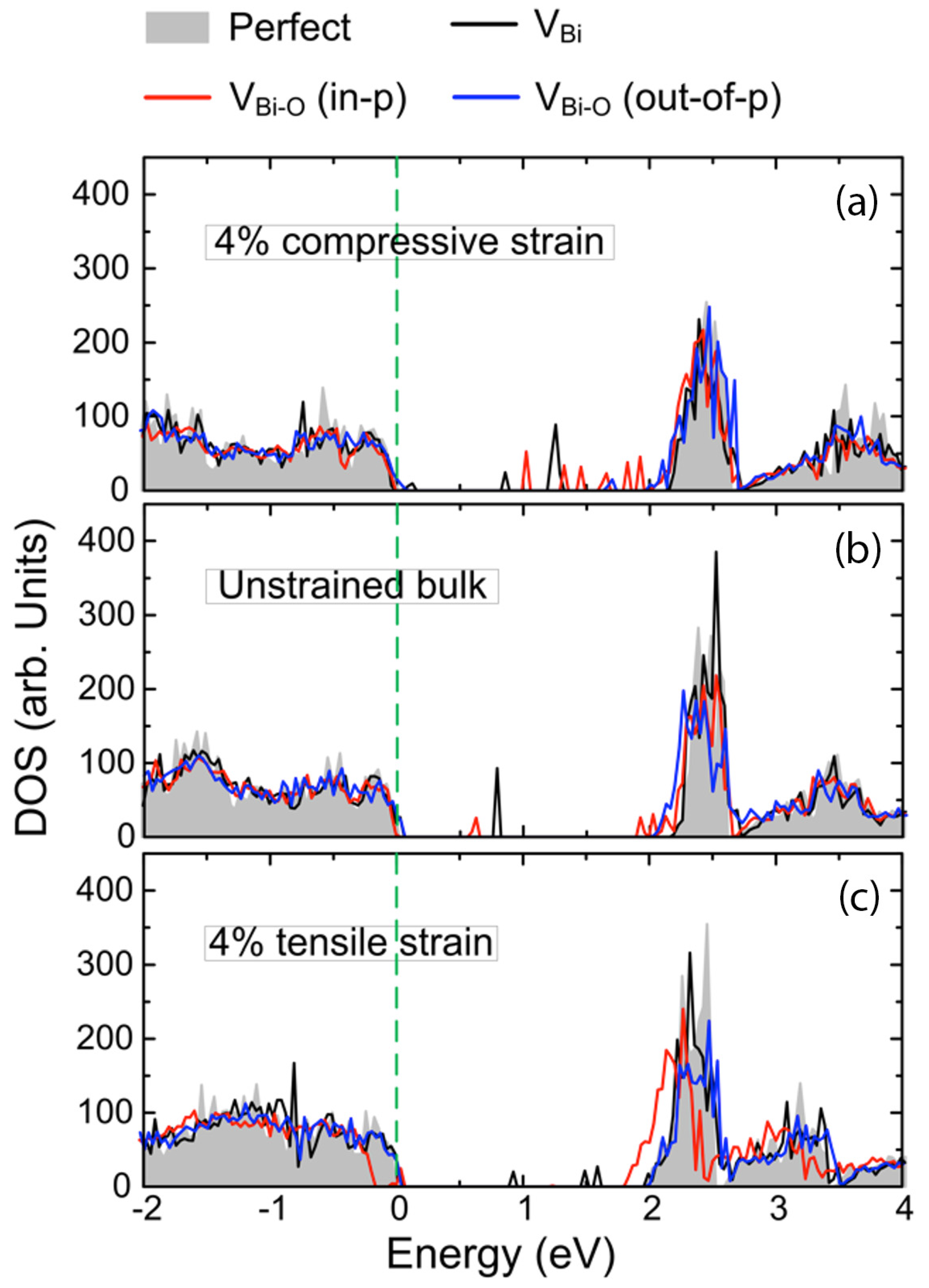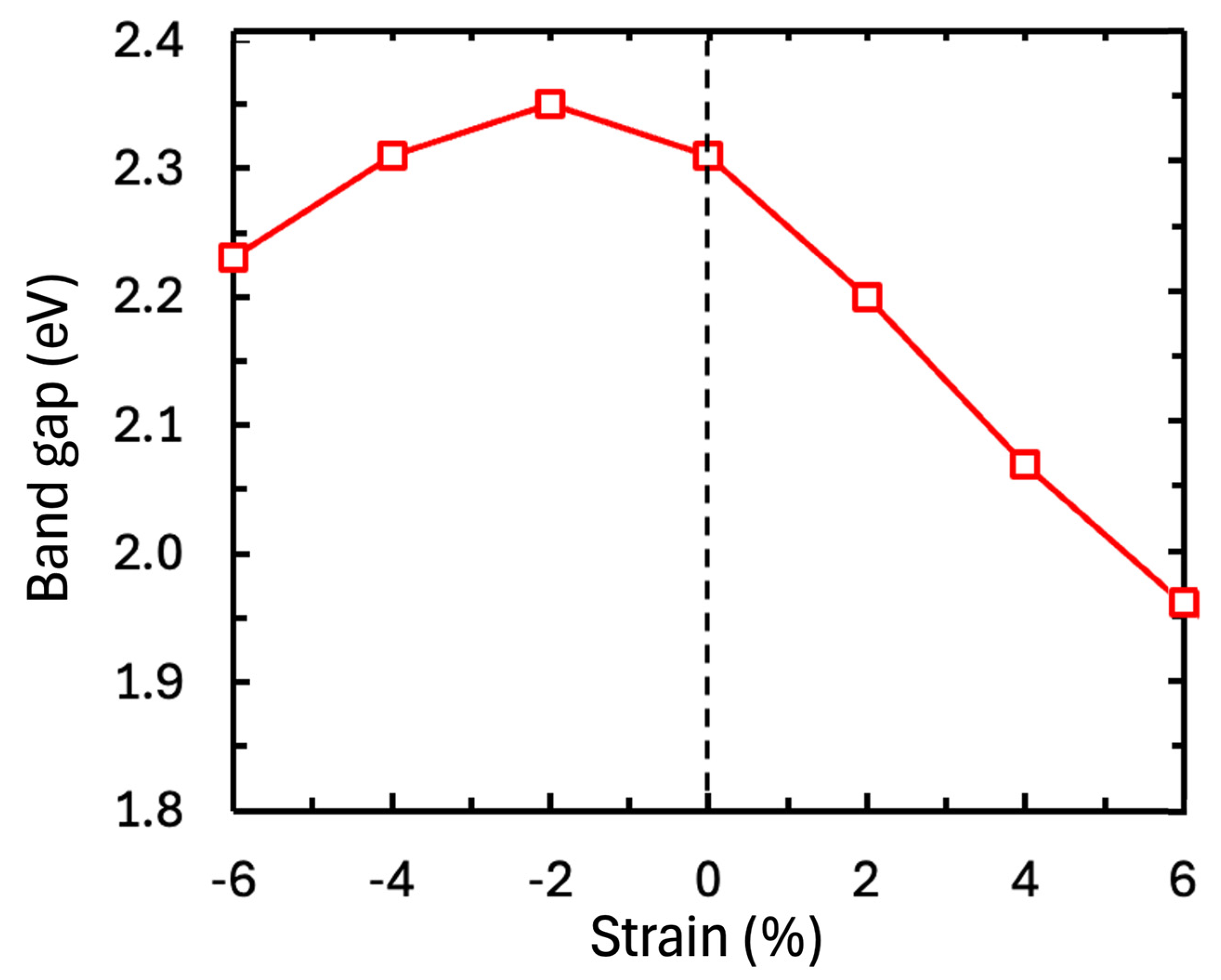First Principles Study of Bismuth Vacancy Formation in (111)-Strained BiFeO3
Abstract
1. Introduction
2. Computational Methods
3. Results and Discussion
3.1. Bismuth Vacancies with Electronic Charge Compensation
3.2. Bismuth Vacancies with Ionic Charge Compensation
3.3. Structural Changes and Polarization
3.4. Electronic Structure
3.5. Implications for Thin Film Synthesis and Domain Walls
4. Conclusions
Supplementary Materials
Author Contributions
Funding
Institutional Review Board Statement
Informed Consent Statement
Data Availability Statement
Conflicts of Interest
References
- Catalan, G.; Scott, J.F. Physics and Applications of Bismuth Ferrite. Adv. Mater. 2009, 21, 2463–2485. [Google Scholar] [CrossRef]
- Hemme, P.; Philippe, J.-C.; Medeiros, A.; Alekhin, A.; Houver, S.; Gallais, Y.; Sacuto, A.; Forget, A.; Colson, D.; Mantri, S.; et al. Tuning the multiferroic properties of BiFeO3 under uniaxial strain. Phys. Rev. Lett. 2023, 131, 116801. [Google Scholar] [CrossRef] [PubMed]
- Prakash, C.; Yadav, A.K.; Dixit, A. Low power highly flexible BiFeO3-based resistive random access memory (RRAM) with the coexistence of negative differential resistance (NDR). Phys. Chem. Chem. Phys. 2023, 25, 19868. [Google Scholar] [CrossRef]
- Ramesh, R.; Spaldin, N.A. Multiferroics: Progress and prospects in thin films. Nat. Mater. 2007, 6, 21–29. [Google Scholar] [CrossRef]
- Martin, L.W.; Rappe, A.M. Thin-film ferroelectric materials and their applications. Nat. Rev. Mater. 2016, 2, 16087. [Google Scholar] [CrossRef]
- Wang, J.; Neaton, J.B.; Zheng, H.; Nagarajan, V.; Ogale, S.B.; Liu, B.; Viehland, D.; Vaithyanathan, V.; Schlom, D.G.; Waghmare, U.V.; et al. Epitaxial BiFeO3 Multiferroic Thin Film Heterostructures. Science 2003, 299, 1719–1722. [Google Scholar] [CrossRef] [PubMed]
- Li, J.; Wang, J.; Wuttig, M.; Ramesh, R.; Wang, N.; Ruette, B.; Pyatakov, A.P.; Zvezdin, A.K.; Viehland, D. Dramatically enhanced polarization in (001), (101), and (111) BiFeO3 thin films due to epitiaxial-induced transitions. Appl. Phys. Lett. 2004, 84, 5261–5263. [Google Scholar] [CrossRef]
- Jang, H.W.; Ortiz, D.; Baek, S.; Folkman, C.M.; Das, R.R.; Shafer, P.; Chen, Y.; Nelson, C.T.; Pan, X.; Ramesh, R.; et al. Domain Engineering for Enhanced Ferroelectric Properties of Epitaxial (001) BiFeO Thin Films. Adv. Mater. 2009, 21, 817–823. [Google Scholar] [CrossRef]
- Infante, I.C.; Lisenkov, S.; Dupe, B.; Bibes, M.; Fusil, S.; Jacquet, E.; Geneste, G.; Petit, S.; Courtial, A.; Juraszek, J.; et al. Bridging multiferroic phase transitions by epitaxial strain in BiFeO3. Phys. Rev. Lett. 2010, 105, 057601. [Google Scholar] [CrossRef]
- Zeches, R.J.; Rossell, M.D.; Zhang, J.X.; Hatt, A.J.; He, Q.; Yang, C.H.; Kumar, A.; Wang, C.H.; Melville, A.; Adamo, C.; et al. A strain-driven morphotropic phase boundary in BiFeO3. Science 2009, 326, 977–980. [Google Scholar] [CrossRef]
- Hatt, A.J.; Spaldin, N.A. Ederer, Strain-induced isosymmetric phase ransition in BiFeO3. Phys. Rev. B 2010, 81, 054109. [Google Scholar] [CrossRef]
- Béa, H.; Dupé, B.; Fusil, S.; Mattana, R.; Jacquet, E.; Warot-Fonrose, B.; Wilhelm, F.; Rogalev, A.; Petit, S.; Cros, V.; et al. Evidence for Room-Temperature Multiferroicity in a Compound with a Giant Axial Ratio. Phys. Rev. Lett. 2009, 102, 217603. [Google Scholar] [CrossRef] [PubMed]
- Dedon, L.R.; Saremi, S.; Chen, Z.H.; Damodaran, A.R.; Apgar, B.A.; Gao, R.; Martin, L.W. Nonstoichiometry, structure, and properties of BiFeO3 films. Chem. Mater. 2016, 28, 5952. [Google Scholar] [CrossRef]
- Lahmar, A.; Zhao, K.; Habouti, S.; Dietze, M.; Solterbeck, C.-H.; Es-Souni, M. Off-stoichiometry effects on BiFeO3 thin films. Solid State Ionics 2011, 202, 1–5. [Google Scholar] [CrossRef]
- Kim, Y.M.; Morozovska, A.; Eliseev, E.; Oxley, M.P.; Mishra, R.; Selbach, S.M.; Grande, T.; Pantelides, S.T.; Kalinin, S.V.; Borisevich, A.Y. Direct observation of ferroelectric field effect and vacancy-controlled screening at the BiFeO3/LaxSr1−xMnO3 interface. Nat. Mater. 2014, 13, 1019. [Google Scholar] [CrossRef]
- Kalinin, S.V.; Spaldin, N.A. Functional Ion Defects in Transition Metal Oxides. Science 2013, 341, 858–859. [Google Scholar] [CrossRef]
- Yuan, H.; Pal, S.; Forrester, C.; He, Q.; Briscoe, J. Understanding the impact of Bi stoichiometry towards optimized BiFeO3 photocathodes: Structure, mor-phology, defects and ferroelectricity. J. Mater. Chem. A Mater. 2024, 28, 17422. [Google Scholar] [CrossRef] [PubMed]
- Prasad, N.P.; Rohnke, M.; Verheijen, M.A.; Sturm, J.M.; Hofmann, J.P.; Hensen, E.J.M.; Bieberle-Hutter, A. Role of excess Bi on the properties and per-formance of BiFeO3 thin-film photocathodes. ACS Appl. Energy. Mater. 2023, 6, 12237. [Google Scholar] [CrossRef]
- Rojac, T.; Bencan, A.; Drazic, G.; Sakamoto, N.; Ursic, H.; Jancar, B.; Tavcar, G.; Makarovic, M.; Walker, J.; Malic, B.; et al. Domain-wall conduction in ferroelectric BiFeO3 controlled by accumulation of charged defects. Nat. Mater. 2016, 16, 322–327. [Google Scholar] [CrossRef]
- Seidel, J.; Martin, L.W.; He, Q.; Zhan, Q.; Chu, Y.H.; Rother, A.; Hawkridge, M.E.; Maksymovych, P.; Yu, P.; Gajek, M.; et al. Conduction at domain walls in oxide multiferroics. Nat. Mater. 2009, 8, 229–234. [Google Scholar] [CrossRef]
- Aschauer, U.; Pfenninger, R.; Selbach, S.M.; Grande, T.; Spaldin, N.A. Strain-controlled oxygen vacancy formation and ordering in CaMnO3. Phys. Rev. B 2013, 88, 054111. [Google Scholar] [CrossRef]
- Aschauer, U.; Vonrüti, N.; Spaldin, N.A. Effect of epitaxial strain on cation and anion vacancy formation in MnO. Phys. Rev. B 2015, 92, 054103. [Google Scholar] [CrossRef]
- Hallsteinsen, I.; Boschker, J.E.; Nord, M.; Lee, S.; Rzchowski, M.; Vullum, P.E.; Grepstad, J.K.; Holmestad, R.; Eom, C.B.; Tybell, T. Surface stability of epitaxial La0.7Sr0.3MnO3 thin films on (111)-oriented SrTiO3. J. Appl. Phys. 2013, 113, 183512. [Google Scholar] [CrossRef]
- Blöchl, P.E. Projector augmented-wave method. Phys. Rev. B 1994, 50, 17953–17979. [Google Scholar] [CrossRef] [PubMed]
- Kresse, G.; Joubert, D. From ultrasoft pseudopotentials to the projector augmented-wave method. Phys. Rev. B 1999, 59, 1758–1775. [Google Scholar] [CrossRef]
- Kresse, G.; Furthmuller, J. Efficient iterative schemes for ab initio total-energy calculations using a plane-wave basis set. Phys. Rev. B 1996, 54, 11169. [Google Scholar] [CrossRef]
- Anisimov, V.I.; Zaanen, J.; Andersen, O.K. Band theory and Mott insulators: Hubbard U instead of Stoner I. Phys. Rev. B 1991, 44, 943–954. [Google Scholar] [CrossRef]
- Dudarev, S.L.; Botton, G.A.; Savrasov, S.Y.; Humphreys, C.J.; Sutton, A.P. Electron-energy-loss spectra and the structural stability of nickel oxide: An LSDA+U study. Phys. Rev. B 1998, 57, 1505–1509. [Google Scholar] [CrossRef]
- Perdew, J.P.; Ruzsinszky, A.; Csonka, G.I.; Vydrov, O.A.; Scuseria, G.E.; Constantin, L.A.; Zhou, X.; Burke, K. Restoring the Density-Gradient Expansion for Exchange in Solids and Surfaces. Phys. Rev. Lett. 2008, 100, 136406, Erratum in 2009, 102, 039902. [Google Scholar] [CrossRef]
- Chen, J.Y.; Wang, Y.; Wang, H.; Zhang, S.M.; Deng, Y. Bi deficiency-tuned functionality in multiferroic Bi1-δFe0.95Mn0.05O3 films. Sci. Rep. 2016, 6, 19385. [Google Scholar] [CrossRef]
- Zhang, Z.; Wu, P.; Chen, L.; Wang, J. Density functional theory plus U study of vacancy formations in bismuth ferrite. Appl. Phys. Lett. 2010, 96, 232906. [Google Scholar] [CrossRef]
- Ren, X. Large electric-field-induced strain in ferroelectric crystals by point-defect-mediated reversible domain switching. Nat. Mater. 2004, 3, 91–94. [Google Scholar] [CrossRef] [PubMed]
- Eichel, R.A.; Erhart, P.; Traskelin, P.; Albe, K.; Kungl, H.; Hoffmann, M.J. Defect-dipole formation in copper-doped PbTiO3 ferroelectrics. Phys. Rev. Lett. 2008, 100, 095504. [Google Scholar] [CrossRef]
- Paudel, T.R.; Jaswal, S.S.; Tsymbal, E.Y. Intrinsic defects in multiferroic BiFeO3 and their effect on magnetism. Phys. Rev. B 2012, 85, 104409. [Google Scholar] [CrossRef]
- Wefring, E.T.; Einarsrud, M.-A. Grande, Electrical conductivity and thermopower of (1-x)BiFeO3–xBi0.5K0.5TiO3 (x=0.1, 0.2) ceramics near the ferroelec-tric to paraelectric phase transition. Phys. Chem. Chem. Phys. 2015, 17, 9420–9428. [Google Scholar] [CrossRef]
- Xia, L.; Tybell, T.; Selbach, S.M. Bi vacancy formation in BiFeO3 epitaxial thin films under compressive (001)-strain from first principles. J. Mater. Chem. C 2019, 7, 4870–4878. [Google Scholar] [CrossRef]





| Type | Orientation of VBi-VO Pair | VBi-VO Distance (Å) | Formation Enthalpy of Vacancy Pair (eV) |
|---|---|---|---|
| I | OP | 2.32 | 3.60 |
| II | OP | 3.35 | 3.68 |
| III | IP | 2.45 | 4.19 |
| IV | IP | 3.23 | 3.97 |
Disclaimer/Publisher’s Note: The statements, opinions and data contained in all publications are solely those of the individual author(s) and contributor(s) and not of MDPI and/or the editor(s). MDPI and/or the editor(s) disclaim responsibility for any injury to people or property resulting from any ideas, methods, instructions or products referred to in the content. |
© 2024 by the authors. Licensee MDPI, Basel, Switzerland. This article is an open access article distributed under the terms and conditions of the Creative Commons Attribution (CC BY) license (https://creativecommons.org/licenses/by/4.0/).
Share and Cite
Xia, L.; Tybell, T.; Selbach, S.M. First Principles Study of Bismuth Vacancy Formation in (111)-Strained BiFeO3. Materials 2024, 17, 5397. https://doi.org/10.3390/ma17225397
Xia L, Tybell T, Selbach SM. First Principles Study of Bismuth Vacancy Formation in (111)-Strained BiFeO3. Materials. 2024; 17(22):5397. https://doi.org/10.3390/ma17225397
Chicago/Turabian StyleXia, Lu, Thomas Tybell, and Sverre M. Selbach. 2024. "First Principles Study of Bismuth Vacancy Formation in (111)-Strained BiFeO3" Materials 17, no. 22: 5397. https://doi.org/10.3390/ma17225397
APA StyleXia, L., Tybell, T., & Selbach, S. M. (2024). First Principles Study of Bismuth Vacancy Formation in (111)-Strained BiFeO3. Materials, 17(22), 5397. https://doi.org/10.3390/ma17225397






